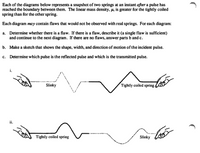
College Physics
11th Edition
ISBN: 9781305952300
Author: Raymond A. Serway, Chris Vuille
Publisher: Cengage Learning
expand_more
expand_more
format_list_bulleted
Concept explainers
Question

Transcribed Image Text:Each of the diagrams below represents a snapshot of two springs at an instant after a pulse has
reached the boundary between them. The linear mass density, µ, is greater for the tightly coiled
spring than for the other spring.
Each diagram may contain flaws that would not be observed with real springs. For each diagram:
a. Determine whether there is a flaw. If there is a flaw, describe it (a single flaw is sufficient)
and continue to the next diagram. If there are no flaws, answer parts b and c.
b. Make a sketch that shows the shape, width, and direction of motion of the incident pulse.
c. Determine which pulse is the reflected pulse and which is the transmitted pulse.
Slinky
Tightly coiled spring
ii.
Tightly coiled spring
Slinky
Expert Solution
This question has been solved!
Explore an expertly crafted, step-by-step solution for a thorough understanding of key concepts.
This is a popular solution
Trending nowThis is a popular solution!
Step by stepSolved in 4 steps with 1 images

Knowledge Booster
Learn more about
Need a deep-dive on the concept behind this application? Look no further. Learn more about this topic, physics and related others by exploring similar questions and additional content below.Similar questions
- Which of the following statements best describes the wave below. Select all that apply. A. small trough B. large trough C. low amplitude D. high amplitudearrow_forwardPlease explain parts c, d, and e. Please include significant figures and units. Thanks for your help!arrow_forwardwhat is the period, frequency, and peak amplitude of the viberation?arrow_forward
- 5. Simple Harmonic Motion: An object is attached to a coiled spring. It is pulled down a distance of 6 inches from its equilibrium position and released. The period of the motion is 4 seconds. a. Show your work for modeling an equation of the objects simple harmonic motion d = acos wt where d is distance from the rest position and the period is , w > 0. A hand sketch may be helpful, but is not required. b. What is the frequency? c. When t = 3 find the distance and interpret it.arrow_forwardPlease provide details about your resolution process. Please show complete, organized and correct work for each question. Questions without complete and clear work will earn no points. You’re welcome to use your textbook and notes, but no calculators. One way to tune a piano is to strike a tuning fork (which emits only one specific frequency), then immediately strike the piano key for the frequency being sounded by the fork, and listen for beats. If the frequency of an out-of-tune A4string is 420.0 Hz, and a tuner strikes an A4 tuning fork (frequency 440.0 Hz),a. …what beat frequency will the tuner hear?a) ????? = _____________________b. …and what frequency note will the tuner hear?b) ????? = _____________________arrow_forwardPart A and Barrow_forward
arrow_back_ios
arrow_forward_ios
Recommended textbooks for you
 College PhysicsPhysicsISBN:9781305952300Author:Raymond A. Serway, Chris VuillePublisher:Cengage Learning
College PhysicsPhysicsISBN:9781305952300Author:Raymond A. Serway, Chris VuillePublisher:Cengage Learning University Physics (14th Edition)PhysicsISBN:9780133969290Author:Hugh D. Young, Roger A. FreedmanPublisher:PEARSON
University Physics (14th Edition)PhysicsISBN:9780133969290Author:Hugh D. Young, Roger A. FreedmanPublisher:PEARSON Introduction To Quantum MechanicsPhysicsISBN:9781107189638Author:Griffiths, David J., Schroeter, Darrell F.Publisher:Cambridge University Press
Introduction To Quantum MechanicsPhysicsISBN:9781107189638Author:Griffiths, David J., Schroeter, Darrell F.Publisher:Cambridge University Press Physics for Scientists and EngineersPhysicsISBN:9781337553278Author:Raymond A. Serway, John W. JewettPublisher:Cengage Learning
Physics for Scientists and EngineersPhysicsISBN:9781337553278Author:Raymond A. Serway, John W. JewettPublisher:Cengage Learning Lecture- Tutorials for Introductory AstronomyPhysicsISBN:9780321820464Author:Edward E. Prather, Tim P. Slater, Jeff P. Adams, Gina BrissendenPublisher:Addison-Wesley
Lecture- Tutorials for Introductory AstronomyPhysicsISBN:9780321820464Author:Edward E. Prather, Tim P. Slater, Jeff P. Adams, Gina BrissendenPublisher:Addison-Wesley College Physics: A Strategic Approach (4th Editio...PhysicsISBN:9780134609034Author:Randall D. Knight (Professor Emeritus), Brian Jones, Stuart FieldPublisher:PEARSON
College Physics: A Strategic Approach (4th Editio...PhysicsISBN:9780134609034Author:Randall D. Knight (Professor Emeritus), Brian Jones, Stuart FieldPublisher:PEARSON

College Physics
Physics
ISBN:9781305952300
Author:Raymond A. Serway, Chris Vuille
Publisher:Cengage Learning

University Physics (14th Edition)
Physics
ISBN:9780133969290
Author:Hugh D. Young, Roger A. Freedman
Publisher:PEARSON

Introduction To Quantum Mechanics
Physics
ISBN:9781107189638
Author:Griffiths, David J., Schroeter, Darrell F.
Publisher:Cambridge University Press

Physics for Scientists and Engineers
Physics
ISBN:9781337553278
Author:Raymond A. Serway, John W. Jewett
Publisher:Cengage Learning

Lecture- Tutorials for Introductory Astronomy
Physics
ISBN:9780321820464
Author:Edward E. Prather, Tim P. Slater, Jeff P. Adams, Gina Brissenden
Publisher:Addison-Wesley

College Physics: A Strategic Approach (4th Editio...
Physics
ISBN:9780134609034
Author:Randall D. Knight (Professor Emeritus), Brian Jones, Stuart Field
Publisher:PEARSON